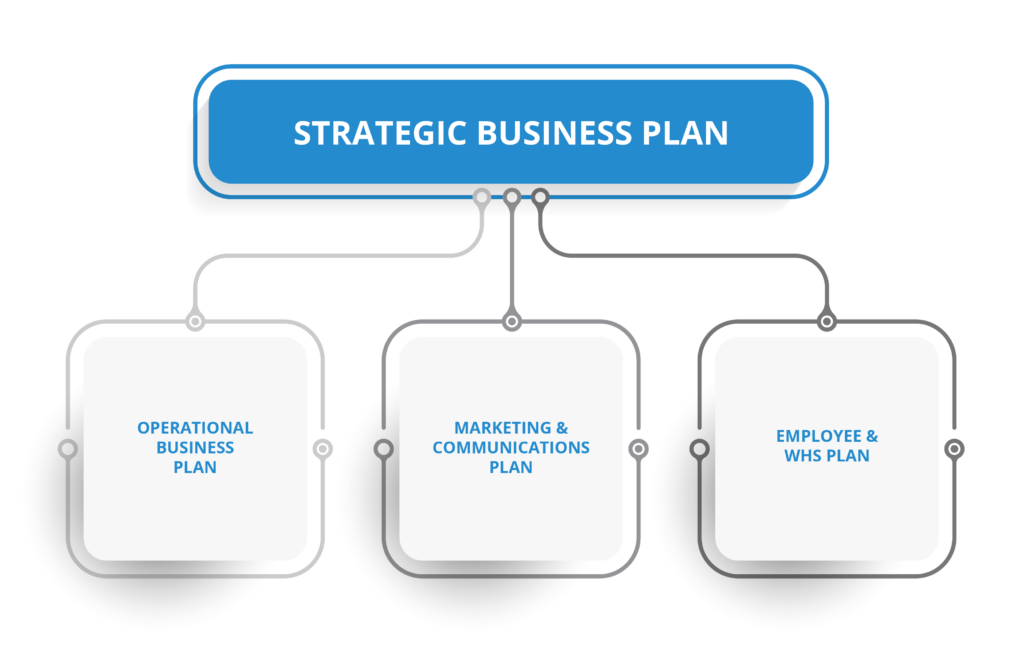How to create a One Page Strategic Business Plan
- Home
- Articles
- Tools & Templates
- How to create a One Page Strategic Business Plan

A One Page Strategic Business Plan is not a ‘one-hour strategic business plan.’ Each element should be researched and considered to ensure you are giving the business the best chance of success.
Our One Page Strategic Business Plan Template can be used either as a stand-alone document or as an executive summary.
We have developed a guide to support you complete our Strategic Business Plan Template. This includes the following sections:
- Business Purpose = why you exist
- Situation Analysis = what’s happening externally and internally
- Business Priorities = what’s most important
- Future goal = what does the big picture success look like?
- Business Objectives = the results you want to achieve in 1-3 years
- Strategies = management decisions to achieve the objectives
What is a Strategic Business Plan?
A strategic business plan considers three key questions:
- What is the purpose of the business – why do you exist?
- What does success look like for the business – what do you want to achieve?
- How will you achieve success – what decisions need to be made.
Thus, a strategic business plan simply defines what the company wants to achieve and how they intend to achieve it – without compromising its purpose or priorities.
When building the plan, what is left out is just as important as what is included. This creates a focus for business owners and can increase their chance of reaching their main goal.
Is a Strategic Business Plan different to a Business Plan?
Yes. A strategic plan is essentially the “thinking” document. It is a series of decisions made by the business owner and/or management team which guides the “doing”. A business plan (which we refer to as an operational plan) is the implementation side.
Under our model, we recommend businesses have only one overarching strategic plan, with a series of operational plans suited to the business needs. For example, a retail business may have an operational plan, a marketing and communications plan and an employee & WHS plan. However, all these plans should support the overarching Strategic Business Plan.

Our One Page Strategic Business Plan Guide
Our One Page Strategic Business Plan Template has six sections to complete and is to be used as a guide for business owners, consultants, and advisors. Based on the business’s industry and current business model, the one-page plan may require more elements or customisation.
Further, some consultants may use different terminology to The Benchmarking Group, therefore, please follow the below guide to ensure you understand our template.
1. Business Purpose = why you exist
The business purpose is the long-term vision for the business. It captures why the business exists and includes two key elements:
- VISION: the ideal world your business is trying to create
- MISSION: what you aim to achieve every day
The vision should be an aspirational statement that is ultimately the result of 100% of your market using your product or service. For example, a fitness company may have a vision statement as: for all Australians to be at their peak physical fitness.
Whereas a mission is what you aim to achieve every day. Therefore, the same company may have a mission to: optimise a client’s fitness journey through one-on-one training.
2. Situation Analysis = what’s happening externally and internally
The situational analysis is a summary of research undertaken. Our model includes four elements:
- INDUSTRY OPPORTUNITY: what are the key trends happening within the industry that will impact the business? For example, are businesses investing in more innovative technologies? Has there been an increase in the number of businesses? Is there a decline in businesses? In addition, this section reviews external influences impacting the industry, such as: have there been government incentives to grow the industry or what impact has COVID had?
- MARKET NEED: who is the target market segment and what problem/s is your business trying to solve for them?
- COMPANY ABILITY: consider your business strengths and your competitor strengths. What do you do well? What do your competitors do better?
- BUSINESS POSITION: a ‘starting point’ for your plan. The items to insert can be changed pending the business focus. We have suggested reviewing customers/people and the businesses financial position.
3. Business Priorities = what’s most important
Unlike business objectives, priorities are big focus areas that are not designed to be measured. They should reflect what is most important to the company, the brand and align with the overall vision and mission. They set boundaries which can guide business decision making. Examples of priorities may be:
- Launching into export markets
- New innovative product range/s
- Becoming an employer of choice
- Diversifying revenue streams
- Excellence in customer service
Priorities should not be time-bound; however, they should be reviewed annually to ensure they are still relevant.
4. Future goal = what does the big picture success look like?
A Future Goal is a 5-10 year goal the business aims to achieve. It should be challenging, but realistic. The point of a larger goal is to give the business a long term planning target – rather than shorter 1-3 year objectives. However, the goal should be the result of the business achieving its objectives.
Examples of Future Goals may be:
- Achieve $10m net profit in 10 years
- Sell business for $2m in 5 years
- Have 1000 subscribers by 2030
5. Business Objectives = the results you want to achieve in 1-3 years
Our model uses SMART Objectives that are Specific, Measurable, Attainable, Relevant and Time-bound. We recommend setting objectives for 1-3years to ensure there is ample time to achieve, yet not so long they become redundant. We recommend setting 3-5 objectives only.
See our guide on Setting SMART Objectives or visit our examples of 50 SMART Objectives for ideas.
6. Strategies = management decisions to achieve the objectives
The word strategy can be confusing in business planning. To clarify, the Strategic Business Plan is the overall document which considers why the company exists and what it wants to achieve.
The Strategies that are within the document relate directly to the objectives. For each objective, there should be 3-5 related strategies.
They are decisions made to give the company the best chance of achieving the objectives. Strategies must be clear and highlight a choice that has been made. In other words, a strategy should also define what is NOT being done.
For example, if a professional services firm has an objective to increase revenue by 20% over the next 12months, they may have strategies to:
- Improve customer retention via a targeted engagement campaign/s
- Focus on cross-selling services to existing customers
- Expand network marketing efforts to grow potential leads
- Reduce number of price discounts given and focus on value-added services.
Once these decisions are made, teams can begin building the implementation plan – which is the daily actions/tasks they do.
Our Benchmark Suite can help you build your client’s Strategic Plan. Find out how!
